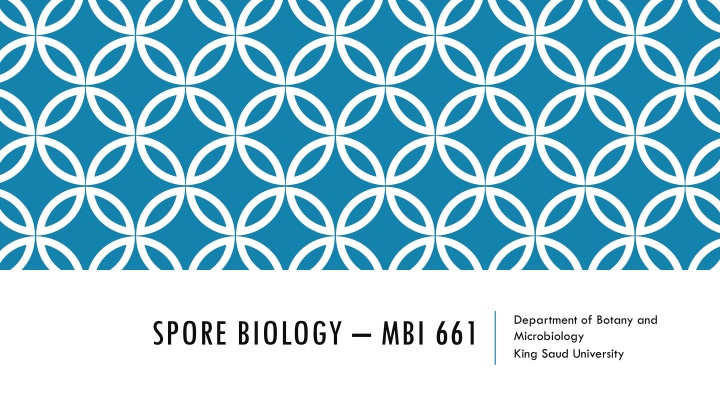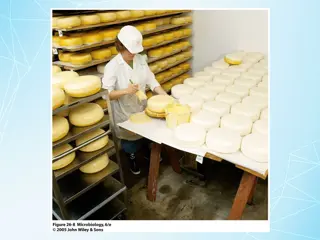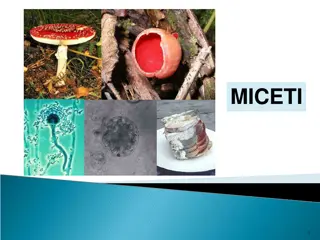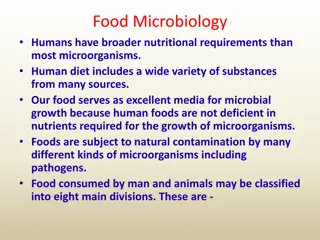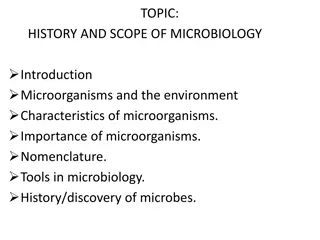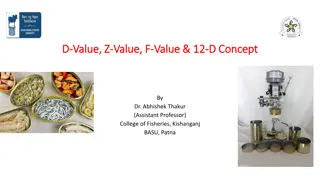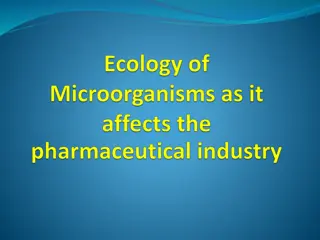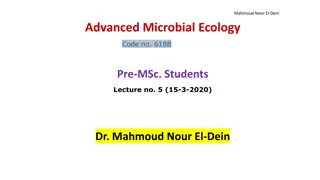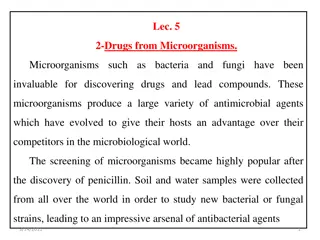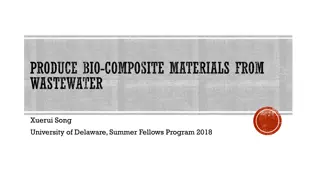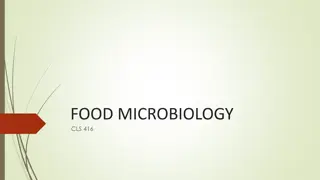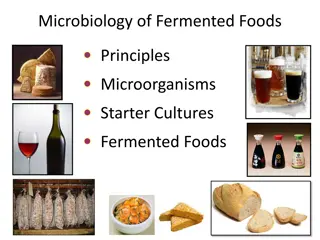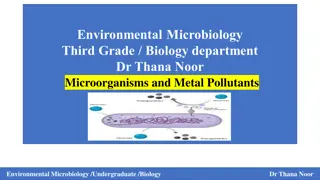Spore Formation in Microorganisms
Sporulation is the process of spore formation in microorganisms as an adaptive response to unfavorable conditions, aiding survival. Different types of spores exist, produced by various organisms like bacteria, fungi, and plants. Learn about the spore biology process and examples in this detailed guide.
Download Presentation

Please find below an Image/Link to download the presentation.
The content on the website is provided AS IS for your information and personal use only. It may not be sold, licensed, or shared on other websites without obtaining consent from the author.If you encounter any issues during the download, it is possible that the publisher has removed the file from their server.
You are allowed to download the files provided on this website for personal or commercial use, subject to the condition that they are used lawfully. All files are the property of their respective owners.
The content on the website is provided AS IS for your information and personal use only. It may not be sold, licensed, or shared on other websites without obtaining consent from the author.
E N D
Presentation Transcript
Department of Botany and Microbiology King Saud University SPORE BIOLOGY MBI 661
SPORULATION Definition, Process, Examples Bacteria, Fungi, Amoeba
DEFINITION: WHAT IS SPORULATION? Essentially, sporulation refers to the formation of spores from vegetative cells during unfavorable environmental conditions. As such, it may be described as an adaptive response that allows the organism to survive given adverse conditions (radiation, extreme heat or cold, lack of nutrition etc).
SPORULATION Compared to vegetative cells, spores (formed during sporulation) are multilayered structures that tend to be dormant (or relatively dormant). These characteristics make it possible for some of the spores to preserve the genetic content of the organism during harsh environmental conditions. During certain unfavorable conditions (depending on the organism), some of the vegetative cells go through a series of morphological changes (and some level of programmed gene expression) that ultimately produce spores. Apart from genetic material, spores also contain some cytoplasm, specific acids, ribosome, and the appropriate enzymes among others that allow the spore to germinate during favorable environmental conditions.
ORGANISMS THAT PRODUCE SPORES The term "spore" comes from the Greek word for Seed. Some of the organisms that produce spores include: Plants Algae Protozoa Bacteria Fungi Depending on the organism, spores vary significantly.
DIFFERENT TYPES OF SPORES There are also different types of spores including: Asexual spores (e.g. exogenous spores produced by Conidia oidia) Sexual spores such as Oospores and Zygote Vegetative spores (e.g. Chlamydospores) Megaspores of plants (female gametophyte) Microspores of plants (develop to formmale gametophyte) Endospores - Type of spores that are produced within the organism (e.g. bacteria) Exospores - Exospores are a type of spores that are produced outside the cell (e.g. in the genus Methylosinus)
SPORULATION PROCESS AND EXAMPLES Sporulation in Bacteria A majority of spore-forming bacteria are Gram-negative bacilli (rod-shaped). These include aerobic Bacillus and anaerobic Clostridium species. Although some Gram- negative bacteria have been shown to be capable of producing spores, it is only a few species found in a few genera. * Some filamentous cocci have also been shown to be capable of sporulation (producing endospores)
SPORULATION IN BACTERIA : FOUR TYPES OF SPORES Depending on the type of bacteria, four types of spores are produced. These include: Endospores: Endospores are the most common types of spores. They are typically produced by Clostridium (e.g. Clostridium botulinum), Bacillus (e.g. Bacillus anthracis) and Sporosarcina bacteria (e.g. Sporosarcina ureae).
SPORULATION IN BACTERIA : FOUR TYPES OF SPORES Cysts: Cysts are a group of cells that join together in order to survive harsh environmental conditions. When conditions in the environment become unfavorable, the cells come together in a manner that allows them to survive. They are common in Azotobacter species * Unlike endospores, cysts are non-reproductive cells. They are also less resistant to tough environmental conditions and have a tough cell wall that is waterproof in place of the peptidoglycan layer found on the cell wall of bacterial endospores
SPORULATION IN BACTERIA : FOUR TYPES OF SPORES Myxospores: A myxospore is a type of spore that is produced by myxobacteria/ Myxobacterates (slimy molds bacteria). Referred to as resting cells in some books, myxospores are capable of surviving such harsh environmental conditions as UV light, high temperatures, and desiccation. They are formed within the fruiting body of the bacteria and in contrast to other resting cells; they are formed from specialized spore-bearing structures.
SPORULATION IN BACTERIA : FOUR TYPES OF SPORES Exospores: Exospores are a type of spore that are produced by members of the phylum Actinobacteria. These spores are produced through the budding of mycelium and can survive in harsh environmental conditions better than the vegetative cells.
SPORULATION IN BACTERIA * Although spores play an important role in the life cycle of bacteria, they are not an obligatory stage. As such, they are typically common during unfavorable environmental conditions. * Sporulating bacteria are ubiquitous and can be found in soil, water, and air among other environments in nature. * Compared to the other types of spores, endospores are the most defensive structures capable of surviving harsher environmental conditions. This is largely due to the fact that beneath the thin and delicate exosporium, they have a spore coat that is made up of layers of proteins.
CHARACTERISTICS ASSOCIATED WITH THE HIGH RESISTANCE CAPACITY OF ENDOSPORES Some of the other characteristics associated with the high resistance capacity of endospores include: High dipicolinic acid content High calcium concentration High amounts of SASP (small acid soluble DNA binding proteins)
SPORULATION IN BACTERIA Although unfavorable conditions such as diminishing sources of nutrition play an important role in sporulation, in that they trigger the process, sporulation does not necessarily start taking place right away. Rather, the bacteria will start by trying to move to an area with favorable conditions.
SPORULATION IN BACTERIA For instance, in the event that food sources diminish, the bacteria, using such structures will attempt to move to a new location through such processes as chemotaxis. Other mechanisms to survive may involve an attempt to adapt to the new conditions or changing their mode of reproduction among others. Therefore, sporulation occurs as the last survival strategy. Before the cell commits to sporulation, several conditions must be met. These include: Chromosome integrity Functional Krebs cycle
BASIC MODE OF SPORULATION OF BACILLUS SUBTILIS The end of vegetative growth Phosphorelay system (consisting of a number of kinases (histidine kinases)) transmit information regarding the environmental conditions and conditions of the cell to the Spo0A (master transcriptional regulator) thus activating it - This phase also plays an important role in determining the state of phosphorylation of the intercellular pool of the master transcriptional regulator
BASIC MODE OF SPORULATION OF BACILLUS SUBTILIS * Here, Spo0A with a phosphyl group play an important role in regulating expression of about 121 genes some of which are involved in sporulation - High levels of Spo0A~P promote the process while low levels result in the formation of biofilm.
BASIC MODE OF SPORULATION OF BACILLUS SUBTILIS Stage 1: Axial filamentation and chromosome division - Activation of the master transcriptional regulator is followed by chromosome replication with each chromosome moving to the opposite poles of the cell One of the chromosomes remains in the mother cell while the other is contained in the forespore
BASIC MODE OF SPORULATION OF BACILLUS SUBTILIS Stage II: Asymmetric septation - Origin-proximal regions of the cell are tethered to the opposite poles of the cell Chromosomal DNA stretch forming axial filaments
BASIC MODE OF SPORULATION OF BACILLUS SUBTILIS Stage III: Engulfment - As the cell divides, 30 percent of the origin-proximal portion containing chromosome is covered. This is known as the forespore A section of the cell containing chromosome is engulfed by a membrane as the peptidogycan is synthesized.
BASIC MODE OF SPORULATION OF BACILLUS SUBTILIS Stage IV-V: Cortex and Coat assembly - Synthesis of the peptidoglycan cortex followed by formation of proteinaceous spore coat: In this stage, the spore (mature) is enclosed in two different layers that include the outer coat consisting of different types of proteins and the cortex that consists of a special type of peptidoglycan.
BASIC MODE OF SPORULATION OF BACILLUS SUBTILIS Lysis of the mother cell - The mother cell undergoes lysis/disintegration. Some material from the mother cell may be used to build on the spore coat.
BASIC MODE OF SPORULATION OF BACILLUS SUBTILIS Spore release - Mature spores are released into the environment and are capable of surviving high temperatures, certain chemicals that can destroy the vegetative cell and radiation among other extreme environments. Once environmental conditions improve, the spore can germinate as the organism returns to the original vegetative growth. * Mutation has been shown to result in the production of twin endospores (two viable spores). Some mutations may also produce more than two endospores.
SPORULATION OF FUNGI Fungi are some of the most studied spore-producing organisms in the world. They produce a wide variety of spores that significantly vary in size, shape and other surface features that suit their environment (for dispersal etc). Whereas the spores produced sexually (through meiosis) remain dormant for survival (e.g. ascospores), those that are produced asexually (mitospores) are for dispersal.
SPORULATION OF FUNGI Produced through mitosis, asexual spores are released in high numbers and are genetically identical. This allows them to play an important role in reproduction when they land on the appropriate substrate in the environment following dispersal. * Chlamydospore - This is a type of fungal spore that develops from the hyphal structures during unfavorable conditions. Chlamydospores are characterized by a thick, melanized wall that protects the contents of the spore. Different types of fungi may produce different types of spores.
THE MAIN GROUPS OF FUNGI AND THE TYPE OF SPORES THEY PRODUCE The following are some of the main groups of fungi and the type of spores they produce: Zygomycota - Members of Zygomycota are known as zygomeycetes. They produce both sexual (zygospores) and asexual (sporangiospores) spores. Ascomycota - Ascomycetes also produce both sexual (ascospores) and asexual (conidia) spores. Basidiomycota - Compared to the other groups of fungi, basidiomyecetes are largely known to produce sexual spores that are known as basidiospores.
SPORULATION PROCESS IN YEAST (SACCHAROMYCES CEREVISIAE)
SPORULATION PROCESS IN YEAST * Saccharomyces cerevisiae is also known as Brewer's yeast and is used for brewing, baking and winemaking As with bacteria (Gram-positive bacteria), fungi do not necessarily start forming spores when environmental conditions change. Rather, they attempt to adjust to the new conditions through a number of strategies.
SPORULATION PROCESS IN YEAST When nitrogen sources diminish, Saccharomyces cerevisiae may respond by going into a stationary phase or modifying their morphology. However, in the event that unfavorable conditions persist, spore formation becomes necessary. This involves a process known as meiosis.
SPORULATION PROCESS IN YEAST Early Phase During unfavorable conditions, the organism responds by entering the early phase (first phase of sporulation) of sporulation. During this phase, cell division processes shift from the mitotic cycle in G1 (An interphase stage) and enter the S phase in meiosis.
SPORULATION PROCESS IN YEAST Some of the events that take place during early phase include: DNA replication Homolog recombination and pairing (prophase) * This phase is therefore largely characterized by changes in the machinery of the cell cycle as well as altered RNA processing.
SPORULATION PROCESS IN YEAST Middle Phase The middle phase is characterized by various cytological events. Here, the meiotic process results in the production of haploid nuclei (four) that form four new daughter cells. This involves the modification of the spindle pole bodies to contribute to the formation of prospores (membrane compartments).
SPORULATION PROCESS IN YEAST Some of the other events that take place during this phase include: Post-Golgi secretory vesicles are redirected to promote the regeneration and expansion of the new compartments The prospores grow and engulf the nuclei Other organelles move to the cytoplasmic space that lies between the nuclear membrane and the prospores The nucleus is completely separated from the cytoplasm of the mother cell
SPORULATION PROCESS IN YEAST Late Phase This is the last phase of sporulation and involves the following events: The prospore membrane closes completely A thick wall starts forming around the spores- This also contributes to the maturation of the spores Chromatic compaction in the nucleus of the spores Some of the organelles start regenerating
SPORULATION PROCESS IN YEAST * While given environments may contain various nutrients, the lack of nitrogen and other appropriate nutrient sources may trigger sporulation of species like A. nidulans and result in the growth of hyphae and consequently conidiation. * Before spores start forming, special reproductive hyphae known as sporangiophores are produced.
SPORULATION PROCESS IN YEAST * Compared to sexual reproduction, asexual reproduction is more common in fungi given that it allows for the rapid spread of the organisms. * Some spores are produced in the sporangium (sac) through mitotic division (e.g. conidia) * Fungi spore vary in size and structure. The differences allow them to be effectively dispersed by a variety of agents including wind, animals, and water.
SPORULATION IN AMOEBA Encystment For the most part, amoeba reproduces asexually through such processes as regeneration, binary fission, multiple fission, and sporulation/encystment. For the purposes of this article, we will focus on encystment and sporulation. When unfavorable environmental conditions (extreme cold, heat, starvation etc) such protozoa as amoeba ultimately respond by forming a protective cyst wall.
SPORULATION IN AMOEBA This type of response is known as encystment and is characterized by the following events: Withdrawal of the pseudopodia Formation of a hard protective layer Dormancy
SPORULATION IN AMOEBA * Such bacteria as E. coli, S. enterica and L. monocytogenes among a few others have been shown to survive extreme conditions when inside the cyst of such amoeba as A. castellanii. The cyst protects these organisms from various extreme conditions like high acidity, antibiotics, and insufficient nutrition among others.
SPORULATION IN AMOEBA In the laboratory, encystation can be stimulated by using the non-nutrient medium. For instance, by using a non-nutrient agar that contains about 80 mm of sodium chloride, 15mM of magnesium chloride and 20mM of taurine, researchers have been able to stimulate encystment of A. culbertsoni.
SPORULATION IN AMOEBA As the trophozoites transform into cysts, some of the morphological changes observed include reduced rates of motility, changing into a spherical shape, general cell shrinkage as well as gradual withdrawal of the pseudopodia (temporary cytoplasm- filled projection ).
SPORULATION IN AMOEBA Various studies have shown cyclic AMP to play an important role in amoeba encystation. Here, amines of taurine or other biogenic amines bind to specific receptors on the organisms' membrane. This, in turn, activates adenylate cyclase on the membrane which triggers the encystation process.
SPORULATION IN AMOEBA In addition to the morphological changes observed during encystation, a number of chemical and molecular changes are also evident. These include: A change from aerobic metabolism to anaerobic metabolism and complete dormancy in the end Rapid turnover of phosphorylated compounds Significant loss of cellular RNA, DNA, and other proteins. However, some species have been shown to gradually synthesis RNA and proteins Incorporation of glucose compounds into a polyssacharide
SPORULATION IN AMOEBA Sporulation in amoeba has been observed in social species like Dictyostelium discoideum. This process is unique and results in a mass of spores that are held up on a tapering stalk. During starvation, the amoeba cells come together to form aggregates that in turn elongate for form a migratory slug composed of over 100,000 cells. The slug then becomes upright as prestalk cells located at its tip form a cellulose tube.
SPORULATION IN AMOEBA As cells enter the tube, they vacuolize in and contribute to its strength. From the desired substrate at the bottom of the stalk, prestalk cells climb and enter the stalk followed by the prespore. Once the stalk is complete, the prespore encapsulate and turn to dormant spores that are protected by a protein coat. * Here, it is worth noting that in the course of this process, the cells differentiate into pre-stalk and pre-spores involved in sporulation.
SPORULATION IN AMOEBA * Cells that converge in large numbers are known as myxamoebae. * Once the slug is formed, it has to move to an area with favorable conditions (illuminated) where it transforms into a fruiting body. This is the stalk that is composed of the spore cells. * Vacuoles are created as prestalk cells form stalk cells. * Spores at the top of the stalk are released into the environment and dispersed to other environments. When environmental conditions are favorable in the new environment, the spores germinate to produce active amoeba.
CLASSIFICATION OF SPORES Spores can be classified in several manners. By spore-producing structure In fungi and fungus-like organisms, spores are often classified by the structure in which meiosis and spore production takes place, such as a ''telium'', ''ascus'', ''basidium'', or ''oogonium'', which produce ''teliospore''s, ''ascospore''s, ''basidiospore''s, and ''oospore''s, respectively. Since fungi are often classified according to their spore-producing structures, these spores are often characteristic of a particular taxon of the fungi, such as ''Ascomycota'' or ''Basidiomycota''.
CLASSIFICATION OF SPORES By motility Spores can be differentiated by whether they can move or not. Zoospores can move by means of one or more flagellum and can be found in some algae and fungi. Aplanospores cannot move, but may potentially grow flagella. Autospores cannot move and do not have the potential to ever develop any flagella. Ballistospores are actively discharged from the body of a fungal fruit (such as a mushroom). Statismospores are not actively discharged from the fungal fruit body, similarly to a puffball.
CLASSIFICATION OF SPORES By function Diaspores are dispersal units of fungi, mosses, ferns, fern allies, and some other plants. In fungi, chlamydospores are thick-walled big resting spores; it is the life-stage that survives in unfavorable conditions, such as dry or hot seasons. In fungi, zygospores are spores (hypnozygotes) of zygomycetous fungi, creating by fusion of haploid hyphae of different mating types. That is, they are produced by sexual gametocystogamy and can give rise to a conidiophore ("zygosporangium") with asexual conidiospores.
